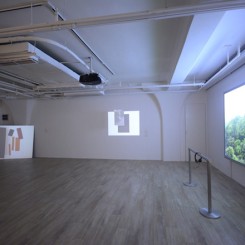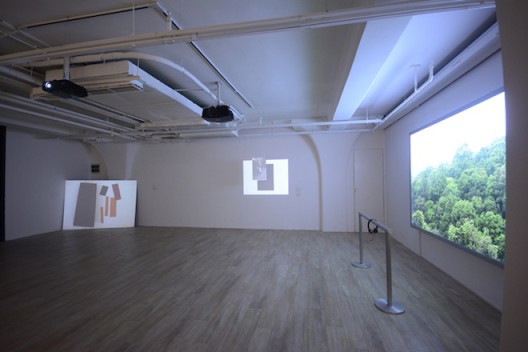“There is no landscape”, Vladimir Nikolic exhibition.
1933 Contemporary (Unit 1–311, No. 611 Liyang Road, Hongkou District, Shanghai), Jan 10–Mar 2, 2015
The Serbian artist Vladimir Nikolic explores vision in his exhibition at Shanghai’s 1933 Contemporary, with many modes of vision incorporated in the show. “Painting” is the first piece the viewer sees upon entering the exhibition space, granting the audience a bird’s eye view of the following process: the artist continually overlays and dismantles two dimensional planar objects of various shapes and colors to form a constantly shifting amalgam of colorful abstract images. It is as if the audience is witnessing a live reenactment of the process of creating one of Matisse’s cut-outs, or scrutinizing a section of a Miró painting. The artist’s childlike approach to decomposing images also calls to mind the Saturday morning cartoons played by parents to win a few more winks. If this work really was a program its title would probably be “How Abstract Art is Made” or “Let’s Learn about Colors and Shapes!” Artists attempt to resolve intrinsic issues of space within painting, as well as two dimensional issues of color and shape; the bird’s eye perspective lends movement and interest to this process of adding and taking away. This particular work is also currently part of a special exhibition taking place at Germanisches National Museum entitled “Looking Down from Above: The Bird’s Eye View”. The piece is being exhibited at the same time as Renaissance artist Jacopo de’Barbari’s woodcut “Map of Venice”. The Germanisches exhibition is attempting to express how humans become curious about their own positions when presented with a different perspective.
Nikolic has always been attempting to analyze and create the sensation of vision through his art; the artist engages in experimentation of stimulating the intrinsic potential of sensory organs. According to the 18th century philosopher George Berkeley, the only elements the human eye is able to perceive are color and light; only through the use of our faculties are we able to accumulate knowledge about our perceptions of perspective, shape, and distance.
Much like learning a language, humans must learn to look; the piece “Portrait of Filippo Riniolo” presents the experience of learning how to look. In the work, a portrait of the artist’s friend is presented inside a standard square frame, staring out at the audience through a light reminiscent of Rembrandt. Just as we become accustomed to the gaze of the subject in the painting, the image begins to undergo minute changes. As the scene begins to shift, the portrait itself also begins to fragment; we become aware that the portrait’s “gaze” actually originates from an image composed of several small mirrors. The handsome Filippo Riniolo was not, after all, watching the audience through a video camera; he was narcissistically admiring his own reflection. However, narcissism is not the subject of this piece. Borrowing from Lacan’s theory of the “Mirror Stage”, the subject’s heightened self-awareness is in fact a reminder to the audience to ask ourselves how we discern what it is we are actually seeing. In the video, the hand which parts the mirror fragments allows us to distinguish between image and mirror through touch. Touch is the only way in which the blind are able to understand the world, but with the proliferation of touch screens in this mobile communications era, touch has become an extension of vision. In the end, Nikolic’s experiments with vision reminds us of the unbridgeable natural divide between seeing and knowing; perhaps the function of art is to attempt to bridge that divide.
The titular piece of this exhibition is the artist’s audiovisual installation “There is No Landscape”, which was created while he was residing in Guangzhou. The landscape referenced in the title is a photograph of a mountain covered in lush vegetation. When viewers put on the earphones provided, they hear a two-person live narration of an artist’s performance piece. Though the narrative of the conversation follows the artist’s ascent into the trees, the landscape, which is reminiscent of Poussin, remains still, merely an unmoving photograph. Language is what switches on our imagination about the scene before us, and the landscape itself becomes the artist’s creative material. It transforms into a work of art, relying on the audience’s imagination to become an image existing inside each of our minds, but which may also have no relation to the photograph of landscape we see before us. When it intersects with threads related to vision explored throughout Nikolic’s exhibition, vision becomes transmuted into an image inside the mind via sound and language—a vista inside each person’s mind.




